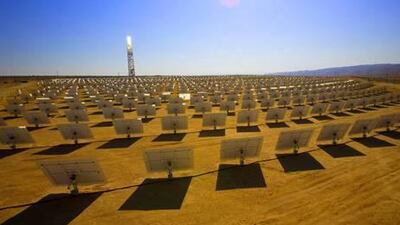Larry Page, Google's new chief executive and the company's co-founder, has marked his appointment by spending US$168 million (Dh616.3m) of the search engine's cash to help fund a solar power plant in California's Mojave Desert.
The Ivanpah solar power plant, which is being developed by BrightSource Energy, will also be financed by the US-based energy giant NRG with clean-energy technology loan guarantees provided by the US Department of Energy. It uses a new technology called "Power Towers", in which a field of mirrors, called heliostats, concentrate the sun's rays onto a solar receiver on top of a tower.
According to Google, the new plant is the environmental equivalent of taking more than 90,000 cars off the road over the lifetime of the plant, projected to be more than 25 years. Google says it has now invested a total of $250m in the clean-energy sector.
But the timing of Google's investment in the Mojave Desert project has led some investors to see the move as an attempt by Mr Page to improve Google's tarnished public image. Under outgoing chief executive Eric Schmidt's leadership, the company's "cool" brand image was severely damaged by an overly cavalier attitude towards personal information entrusted to it by users.
Before investors are swayed by the publicity surrounding investment in isolated projects such as the Ivanpah solar plant, they should also reflect that Google's entire clean-sector investment represents less than 3 per cent of the company's last quarterly advertising revenues.
Even this contribution must also be seen in the context of the IT industry's overall impact on the environment. Although Google does not make the devices that run its internet services, it must at least accept partial responsibility for the negative environmental impact of all the millions of smartphones and computers that either run its Android software or access its services. The IT industry as a whole is now coming under increasingly heavy flak from analysts and industry watchers for its green pretensions.
"IT is not green and never will be," says Doug Washburn, an analyst at Forrester, an international research company.
"While technology vendors continue to make strides to reduce their environmental impacts, IT equipment still suffers design, manufacturing and disposal challenges."
According to Forrester's IT research team, the list of environmental hazards created by the IT industry is very long. The presence, for instance, in IT equipment of highly toxic chemicals with known human health risks creates potential hazards.
The US Environmental Protection Agency warns that exposure to common substances found in today's IT equipment can lead to death or serious illness such as cancer, birth defects, brain and nervous system damage, and mental disturbances. Lead, mercury, cadmium, brominated flame retardants and polyvinyl chloride (PVC) are just a few of the toxic chemicals essential to the manufacture of IT gadgets.
There is also a widespread misconception among many green investors that internet-based service companies, such as Google and its younger rival Facebook, have an extremely low environmental impact when compared with manufacturing companies.
But this view is not born out by scientific study. According to Forrester, the vast computer banks running the data centres such as those operated by Google and Facebook consume 45 per cent of the IT industry's energy usage.
Overall, energy consumption by the internet industry's mushrooming data centres is also set to grow as internet-enabled mobile devices are increasingly adopted in the developing regions of the world.
"With more than 69 per cent of global electricity derived from greenhouse-gas-emitting fossil fuels like coal, petroleum and natural gas, coupled with the booming demand for IT services, operating equipment will further contribute to environmental challenges such as global climate change," says Mr Washburn.
In the current economic climate, Google is like any other major US corporation. Despite its idealistic company motto of "Do No Evil", its two main motivations are cost-cutting and shareholder satisfaction.
Analysts believe that it is the desire to cut operating costs rather than altruistic impulses on the part of Silicon Valley chief executives that will persuade IT companies to reduce their massive environmental footprint.
"Don't be fooled," warns Mr Washburn. "Green IT is as much about saving money as it is about saving the world."
Forrester's April 2010 Global Green IT Online Survey reported that the two main motivations for green IT are the financial drivers to cut energy-related operating expenses and reduce other IT operating expenses.
But IT stocks are also notoriously vulnerable to investor sentiment. The market considers brands such as Google and Apple as being far "cooler" than IT veterans such as Microsoft and Intel. Google, in its turn, feels Facebook's hot breath on its neck.
In this highly competitive and brand-conscious market, green investors can vote with their cash to ensure that the IT industry finally starts to make a full account of its total environmental impact.

